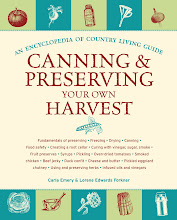For all those serious about self-sufficient gardening, planting early and growing late-transplants are necessary. Plants such as green peppers, eggplants, tomatoes, and cabbage are great to start from seed and germinate indoors. Just start them about 2 months before transplanting.
Read on for Carla Emery's advice for starting transplants:
Sunshine: Start your seeds in the house or greenhouse rather than in a cloche or cold frame, because most seeds require much warmer soil to germinate than they need to grow. Inside you can give them ideal conditions in their tender early stages. They don't need much space. You can grow your transplants on a windowsill that's sunny at least part of the day. For more plants, make shelves across your window. Remove anything underneath that could be harmed by dripping water.
Water: You'll want to water the plants every other day or whenever they look dry. Several light waterings beat one big flood, which has a tendency to go right through, leaving the plant still dry.
Containers:
Milk Cartons?
Mary Ann Shepherd, Del Mar, CA, wrote me, "I use milk cartons as collars to blanch celery, around my new lettuce seedlings to discourage cutworms, and to start all sorts of cuttings (both flowers and vegetables) and seeds. For collars, cut off tops and bottoms. For all else, cut off tops (or open up) and use a tri-cornered beverage opener ('church key') to cut a drain hole on all four sides at the bottom (not in the bottom itself). When I go to transplant I slit the sides and bottom and plant the whole thing - the carton eventually disintegrates and you don't disturb the roots that way. My pine seedlings take about year to germinate and grow to about 4 inches tall, and they have lived happily in milk cartons for up to 2 years before I've transplanted them." Cardboard Boxes.
I sometimes start the plants in "seed flats" (for me, that means a cardboard box with dirt in the bottom) and then transplant to tin cans. If I don't get them out of there pretty fast, the bottoms get too soggy.
Cans.
Cans of any size are good. I like those big tins that canned hams come in, and gallon tins are great. You have to punch small holes in the bottom. Big containers of dirt are better than small ones. I use 1 plant to 1 soup can or peat pot once they are started in the seed flats, or about 6 to a ham can.
Peat Pots.
Plants in peat pots dry out fast and have to be watered every day. Set them out, pot and all, or you'll be breaking off roots that have grown right into the pot side. Tear off the part of the rim that's above ground to prevent it from acting as a wick and causing the plant to lose water. Other than that, and the fact you have to pay for them, peat pots are great. NOTE: Be sure to label each flat with the variety of plant in it.
When to Transplant? The best time to set transplants out is the beginning of a cloudy, rainy spell. Cabbage sets are hardy and can go out in the garden when you plant your green onions. But in my garden, if I plant too early I risk losing my plants to cutworms. A little later is perfect. Tomato sets can go to the garden when you're positive the frosts and near-frosts are over. Green pepper and eggplant sets should wait till the nights are not cold at all. Because plants I set out too early may be wiped out by cutworms or cold, I first set out a sampling and then wait a few days to see what happens.








No comments:
Post a Comment